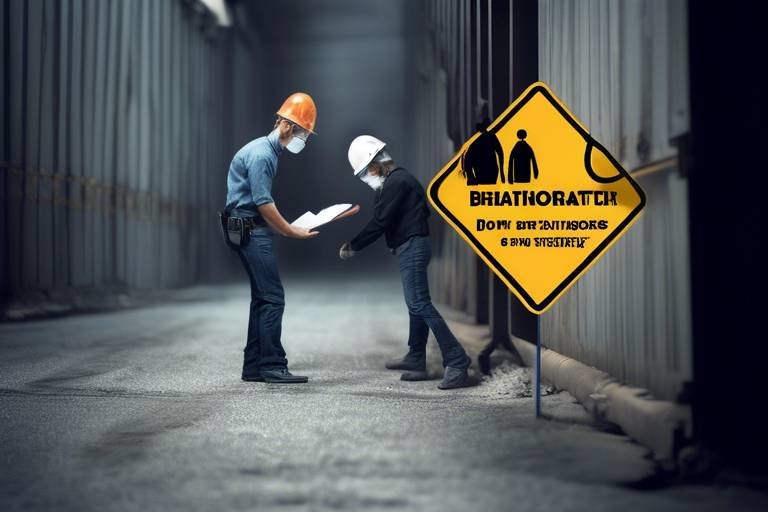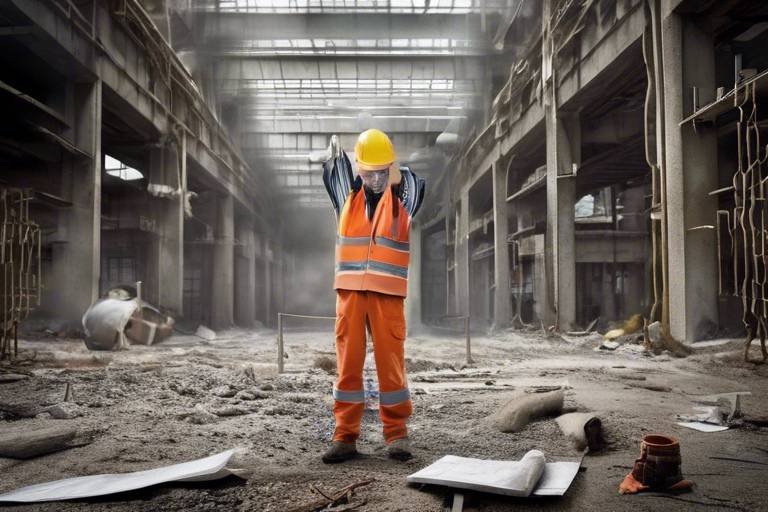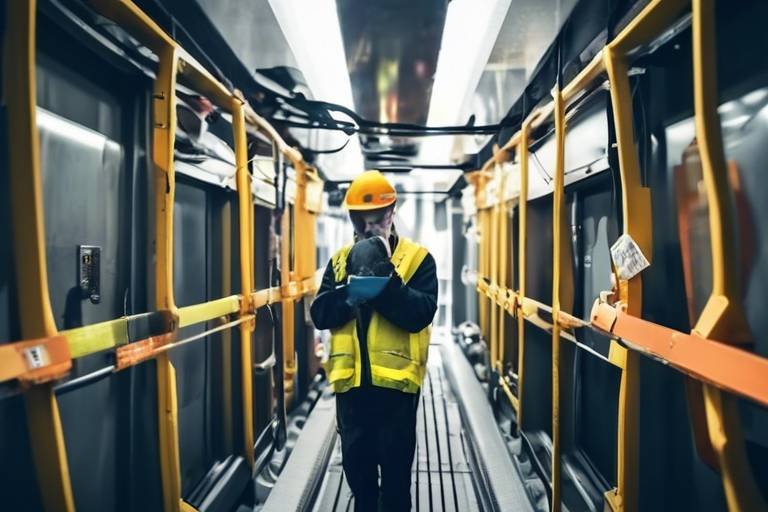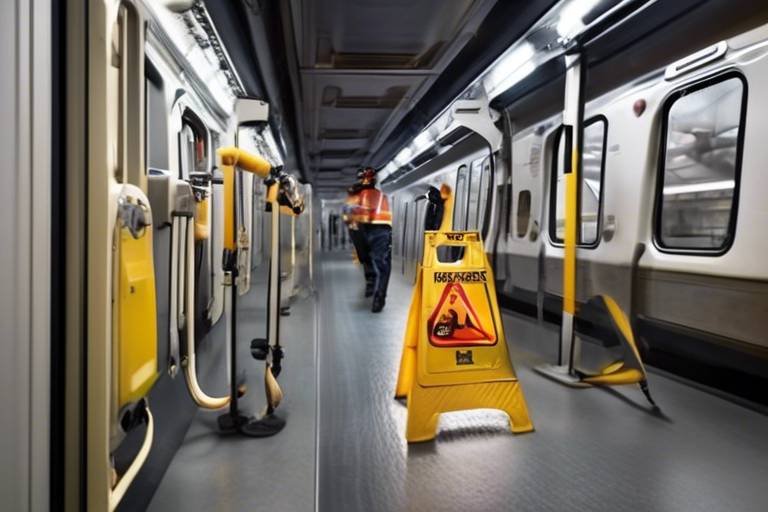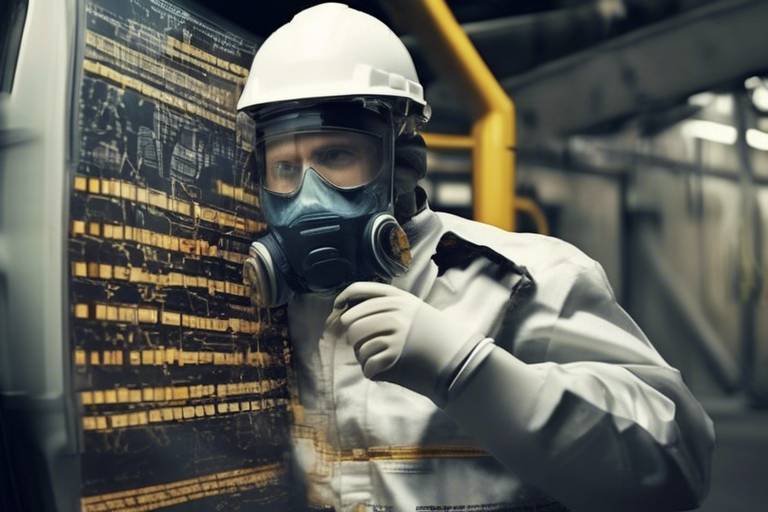How Behavior Changes Affect the Strategies of Safety?
The landscape of safety management is constantly evolving, and at the heart of this evolution is the dynamic nature of human behavior. When we talk about safety strategies, we often think about rules, regulations, and protocols. However, the real game-changer lies in understanding how behavior changes can significantly shape these strategies. Imagine a workplace where every employee instinctively follows safety protocols, not because they have to, but because they genuinely want to. This transformation doesn’t just happen; it requires a deep understanding of behavioral influences and the implementation of strategies that resonate with individuals on a personal level.
Organizations that prioritize behavioral safety are not just ticking boxes; they are investing in a culture that fosters accountability and commitment to safety. By recognizing that behavior is often the most significant factor in safety outcomes, companies can tailor their strategies to not only prevent accidents but also to promote a safer environment. The implications of this approach extend beyond the workplace; they ripple through communities, impacting how individuals perceive and engage with safety in their daily lives.
So, what does it mean to shift focus from traditional safety measures to a more behavior-centric approach? It means understanding that safety is not solely about compliance but about creating a culture where safe behaviors are nurtured and encouraged. This cultural shift can lead to profound changes in how safety strategies are developed and implemented. Organizations that embrace this perspective often see a decrease in incidents and an increase in employee morale, as individuals feel more empowered and responsible for their own safety and that of their colleagues.
As we explore the intricacies of how behavior changes affect safety strategies, it becomes clear that the journey involves identifying the triggers that lead to positive behavior changes. This includes examining the environmental and psychological factors that influence how individuals act in various situations. By doing so, organizations can create tailored interventions that not only address specific safety concerns but also foster a culture of safety that resonates with every member of the team.
Ultimately, the relationship between behavior changes and safety strategies is a vital component of effective safety management. As organizations strive to create safer environments, they must remain vigilant in understanding and adapting to the evolving behaviors of their workforce. By prioritizing behavioral safety, organizations can not only enhance their safety strategies but also cultivate a culture that values and promotes safety at every level.
- What is behavioral safety? Behavioral safety focuses on the actions and behaviors of individuals as key components of workplace safety, aiming to promote safe practices through understanding and modifying behavior.
- How can organizations encourage behavior changes for safety? Organizations can encourage behavior changes by creating a supportive environment, providing training, and implementing feedback systems that reinforce safe practices.
- Why is a strong safety culture important? A strong safety culture promotes shared values and attitudes towards safety, leading to enhanced employee engagement and reduced incidents.
- What role does training play in behavior-based safety programs? Training is essential for instilling safe behaviors, providing employees with the knowledge and skills they need to perform their tasks safely.
- How can organizations measure the impact of behavior changes on safety? Organizations can measure impact through various metrics, including incident rates, employee feedback, and safety audits to assess improvements in safety outcomes.

The Importance of Behavioral Safety
This article explores the impact of behavior changes on safety strategies, discussing the implications for organizations, individuals, and communities in fostering a safer environment through effective behavioral adjustments.
Understanding the significance of behavioral safety is crucial for developing effective safety strategies. Why, you might ask? Well, our behaviors are often the first line of defense when it comes to safety. Think about it: every day, we make countless decisions that either promote safety or put us at risk. By focusing on behavioral safety, organizations can not only reduce accidents but also create a culture where safety becomes second nature.
Behavioral safety emphasizes the idea that safety is not just about rules and regulations; it's about the actions and attitudes of individuals. When employees feel empowered to take ownership of their safety and the safety of others, they are more likely to engage in safe practices. This empowerment can lead to a profound shift in the workplace culture, fostering an environment where everyone actively participates in safety initiatives.
Moreover, prioritizing behavioral approaches in safety management can yield numerous benefits:
- Enhanced Awareness: Employees become more aware of their surroundings and potential hazards.
- Reduced Incidents: A focus on behavior leads to fewer accidents and injuries.
- Increased Engagement: Workers feel more involved in safety discussions and initiatives.
- Improved Morale: A safer workplace boosts overall employee satisfaction and morale.
In essence, behavioral safety is about creating a proactive approach to safety management. It encourages organizations to look beyond traditional safety measures and consider the human element. By understanding how behavior influences safety outcomes, organizations can tailor their strategies to address specific behavioral patterns and triggers, leading to a more effective safety culture.
Recognizing the triggers that lead to behavior changes is essential for implementing effective safety strategies. This section discusses common factors that influence safety-related behaviors and how organizations can address them.
Environmental factors play a vital role in shaping behavior. This subheading examines how workplace design and surroundings impact safety behaviors and the importance of creating a conducive environment for safety.
The physical environment significantly affects employee behavior. This section explores how layout, equipment, and facilities can either promote or hinder safe practices within an organization.
A strong safety culture can drive positive behavior changes. This subsection discusses the elements of a safety culture and how fostering it can enhance overall safety strategies.
Psychological aspects, such as motivation and perception, influence behavior change. This part delves into how understanding these factors can help organizations tailor their safety strategies effectively.
Behavior-based safety programs focus on improving safety through behavior modification. This section outlines the key components of successful programs and their impact on safety outcomes.
Training and education are vital for instilling safe behaviors. This subheading discusses effective training methods and their role in reinforcing safety practices within organizations.
Providing feedback and reinforcement is crucial for sustaining behavior changes. This section highlights how positive reinforcement can encourage safe behaviors and improve overall safety performance.
Evaluating the effectiveness of behavior changes on safety strategies is essential for continuous improvement. This section discusses various metrics and methods for assessing the impact of behavioral adjustments on safety outcomes.
Q: What is behavioral safety?
A: Behavioral safety is an approach that focuses on the actions and attitudes of individuals to enhance safety outcomes in the workplace.
Q: Why is behavioral safety important?
A: It is important because it empowers employees to take ownership of their safety, leading to a safer work environment and reduced incidents.
Q: How can organizations implement behavioral safety?
A: Organizations can implement behavioral safety by fostering a strong safety culture, providing training, and encouraging feedback and reinforcement.
Q: What are some common triggers for behavior change?
A: Common triggers include environmental factors, psychological influences, and organizational culture.

Identifying Behavior Change Triggers
Understanding the triggers that lead to behavior changes is essential for implementing effective safety strategies. Just like a spark ignites a flame, certain factors can prompt individuals to alter their behaviors, especially in safety-critical environments. These triggers can stem from various sources, including environmental cues, organizational policies, and even personal motivations. By identifying these triggers, organizations can better tailor their safety strategies to foster a culture of safety and reduce incidents.
One of the most significant categories of behavior change triggers is environmental influences. This encompasses both the physical and cultural environments that individuals operate within. For instance, a cluttered workspace can lead to distractions and increase the likelihood of accidents. Conversely, a well-organized and clean environment can promote focus and safe practices. Organizations should strive to create spaces that not only comply with safety regulations but also encourage safe behavior through thoughtful design.
Moreover, psychological factors play a pivotal role in shaping behaviors. Motivation, for instance, can be a powerful driver of change. When employees feel personally invested in their safety and the safety of their colleagues, they are more likely to adopt safe practices. It's essential for organizations to foster an environment where individuals feel empowered and responsible for their actions. This can be achieved through open communication, recognition of safe behaviors, and providing resources that help employees understand the importance of safety.
To further illustrate these points, let’s consider some common triggers that can influence behavior changes:
- Management Practices: Leadership plays a crucial role in setting the tone for safety. When managers prioritize safety in their decision-making, employees are more likely to follow suit.
- Peer Influence: The behaviors of coworkers can significantly impact individual actions. A culture that promotes safe practices can encourage everyone to adhere to safety protocols.
- Personal Experiences: Past incidents, whether personal or observed, can serve as powerful reminders of the importance of safety, prompting individuals to change their behavior.
By recognizing these triggers, organizations can implement targeted interventions that address the root causes of unsafe behaviors. For instance, if a lack of motivation is identified as a trigger, organizations can introduce incentive programs that reward safe practices. Similarly, if environmental factors are at play, redesigning workspaces to be more conducive to safety can lead to significant improvements.
Ultimately, identifying behavior change triggers is not just about recognizing what influences individuals; it's about creating a comprehensive safety strategy that encompasses these factors. By doing so, organizations can foster a safer work environment, reduce incidents, and promote a culture of continuous improvement in safety practices.
1. What are behavior change triggers?
Behavior change triggers are factors that prompt individuals to alter their behaviors, particularly in relation to safety. These can include environmental influences, psychological factors, and organizational practices.
2. Why is it important to identify behavior change triggers?
Identifying these triggers helps organizations tailor their safety strategies effectively, leading to improved safety outcomes and a reduction in incidents.
3. How can organizations address negative behavior change triggers?
Organizations can address negative triggers by redesigning workspaces, enhancing communication, providing training, and fostering a strong safety culture.

Environmental Influences
When it comes to safety, the environment we operate in can be a game changer. Think about it: we often underestimate how much our surroundings can influence our behavior. It's like trying to concentrate in a noisy café versus a quiet library. The same principle applies to workplace safety. A well-designed environment can promote safe practices, while a chaotic or poorly structured space can lead to accidents. By understanding these , organizations can create safer workplaces that naturally encourage positive behavior.
One of the main aspects of the physical environment is its layout. Imagine walking into a cluttered workspace where pathways are blocked by equipment. This not only creates a hazard but also sends a message that safety isn't a priority. On the flip side, a clean and organized layout not only enhances productivity but also fosters a culture of safety. To illustrate this point, consider the following table that outlines how different environmental factors can impact safety behaviors:
| Environmental Factor | Impact on Safety Behavior |
|---|---|
| Workspace Layout | Encourages or hinders movement, affecting quick access to safety equipment. |
| Lighting | Poor lighting can lead to accidents; proper lighting enhances visibility and awareness. |
| Noise Levels | High noise can distract employees, leading to unsafe practices. |
| Equipment Condition | Well-maintained equipment promotes safe usage; faulty equipment increases risk. |
Additionally, the cultural environment within an organization plays a crucial role in shaping safety behaviors. A strong safety culture acts like a protective shield, encouraging employees to prioritize safety in their daily tasks. When organizations communicate their commitment to safety through policies, training, and visible leadership involvement, employees are more likely to adopt safe practices. In fact, a culture that rewards safe behavior and openly discusses safety issues creates an environment where individuals feel empowered to make safer choices.
Moreover, the psychological aspect of the environment cannot be overlooked. When employees feel safe and valued, they are more likely to engage in behaviors that reflect those feelings. This includes reporting hazards, participating in safety training, and looking out for their colleagues. It's a bit like how a supportive friend can motivate you to make better choices; the same goes for a supportive workplace environment.
In conclusion, understanding and optimizing environmental influences is vital for enhancing safety strategies. By creating a physical and cultural environment that prioritizes safety, organizations can not only reduce the risk of accidents but also foster a culture where safety becomes a shared responsibility. So, next time you walk into a workplace, take a moment to observe: is it designed for safety, or does it leave room for potential hazards?
- What are some common environmental factors that affect workplace safety?
Common factors include workspace layout, lighting, noise levels, and equipment condition. - How can organizations improve their safety culture?
Organizations can improve safety culture by promoting open communication, providing training, and recognizing safe behaviors. - Why is the physical environment important for safety?
A well-structured physical environment can enhance visibility, reduce distractions, and promote safe practices among employees.

Physical Environment
The within a workplace is more than just a backdrop; it is a dynamic force that shapes how employees behave and interact with safety protocols. Imagine walking into a workspace that is cluttered, poorly lit, and disorganized. What kind of impression does that leave? It can create a sense of chaos and, inadvertently, encourage unsafe practices. Conversely, a well-designed environment can promote a culture of safety and vigilance. The layout of a workspace, the placement of equipment, and even the availability of safety gear can significantly influence employee behavior.
For instance, consider the layout of an industrial site. If machinery is positioned in a way that requires employees to navigate through tight spaces, it can lead to accidents and injuries. On the other hand, a thoughtfully designed layout that allows for clear pathways and easy access to safety equipment can promote safer working habits. Here are some critical aspects of the physical environment that organizations should consider:
- Space Utilization: Efficient use of space can minimize hazards. Open areas can facilitate movement and reduce the risk of collisions.
- Lighting: Proper lighting is essential. Adequate illumination helps employees see potential hazards and perform tasks safely.
- Ergonomics: Ergonomically designed workstations can reduce strain and injury, encouraging employees to maintain safe practices.
Furthermore, the availability of safety equipment, such as fire extinguishers, first-aid kits, and personal protective equipment (PPE), should be easily accessible. When employees see that their organization prioritizes safety through the provision of adequate resources, it fosters a sense of responsibility and encourages them to adopt safer behaviors. A well-maintained physical environment signals to employees that safety is a top priority, which can lead to a positive shift in behavior.
To illustrate this point, let’s look at a simple comparison of two different workplace environments:
| Workplace A | Workplace B |
|---|---|
| Cluttered aisles and poor lighting | Clear pathways and bright, natural light |
| Inaccessible safety equipment | Safety gear readily available and visible |
| Unorganized workspace | Systematic organization and cleanliness |
As seen in the table, the differences between Workplace A and Workplace B are stark. The latter not only promotes safety but also encourages employees to take ownership of their actions. When employees feel safe and supported by their environment, they are more likely to adhere to safety protocols and report unsafe conditions. In this way, the physical environment acts as a catalyst for positive behavior change, reinforcing the overall safety strategy of the organization.

Cultural Environment
The within an organization is a powerful catalyst for driving behavior change, especially when it comes to safety. Imagine walking into a workplace where everyone is genuinely committed to safety; it feels different, right? This commitment often stems from a robust safety culture that prioritizes and values safe practices. A strong safety culture not only encourages employees to adopt safer behaviors but also fosters a sense of shared responsibility. In such an environment, individuals are more likely to look out for one another, creating a ripple effect that enhances overall safety.
So, what exactly constitutes a strong safety culture? It revolves around several key elements:
- Leadership Commitment: Leaders must actively demonstrate their dedication to safety. This includes not just talking the talk but walking the walk by participating in safety training and adhering to safety protocols themselves.
- Open Communication: Encouraging employees to voice their concerns and suggestions about safety creates an atmosphere of trust. When workers feel heard, they are more likely to engage in safe practices.
- Continuous Improvement: A culture that embraces learning from incidents and near misses fosters an environment where safety is constantly evolving. This proactive approach helps identify potential hazards before they turn into accidents.
Moreover, the cultural environment significantly impacts how safety policies are perceived and implemented. If the culture is one of compliance, employees may follow rules only because they feel they have to. However, in a culture that values safety, employees understand the 'why' behind the rules, making them more likely to internalize these practices. This understanding transforms safety from a mere obligation into a shared value.
Consider the analogy of a sports team. A team that works together, communicates openly, and supports one another is far more likely to succeed than one that operates in silos. Similarly, organizations that cultivate a strong safety culture see better safety outcomes because everyone is on the same page, working toward a common goal: a safer workplace.
In conclusion, the cultural environment is not just a backdrop; it is the very foundation upon which safety strategies are built. By prioritizing a strong safety culture, organizations can effectively influence behavior changes that lead to improved safety outcomes, ultimately creating a workplace where safety is everyone's responsibility.
- What is a safety culture? A safety culture refers to the shared values, beliefs, and practices regarding safety within an organization. It influences how employees perceive and prioritize safety in their daily activities.
- How can organizations improve their safety culture? Organizations can enhance their safety culture by fostering open communication, encouraging leadership involvement, and promoting continuous improvement in safety practices.
- Why is a strong safety culture important? A strong safety culture leads to better safety outcomes, as it encourages employees to adopt safe behaviors and look out for one another, reducing the likelihood of accidents and injuries.

Psychological Factors
When we talk about safety in the workplace, we often think about policies, procedures, and equipment. However, the that drive behavior change are just as critical, if not more so. Understanding these factors can be the key to unlocking a safer environment for everyone involved. Have you ever wondered why some employees consistently follow safety protocols while others seem to ignore them? The answers often lie deep within the mind. Psychological elements such as motivation, perception, and even fear can significantly influence how individuals approach safety.
To illustrate, let’s consider motivation. Employees who feel motivated to adhere to safety protocols are more likely to engage in safe practices. This motivation can stem from various sources, including personal values, peer influence, and organizational culture. For instance, if a company promotes a strong safety culture, employees are more likely to feel a sense of responsibility towards their own safety and that of their colleagues. This sense of accountability can be a powerful motivator, leading to a significant reduction in accidents and incidents.
On the other hand, perception plays a crucial role in how safety measures are viewed. If employees perceive safety protocols as unnecessary or overly burdensome, they may be less likely to follow them. This perception can be shaped by past experiences, workplace culture, and even the way safety information is communicated. For example, if safety training is seen as a mere formality rather than a genuine effort to protect employees, it may fail to resonate with them. Therefore, it’s essential for organizations to communicate the importance of safety in a way that is relatable and engaging.
Moreover, fear can also act as a double-edged sword in the realm of safety. While a certain level of fear can encourage compliance—think of the fear of accidents or injuries—it can also lead to adverse effects, such as stress and anxiety. Employees who are constantly worried about making a mistake may become so overwhelmed that they inadvertently compromise their safety. Thus, it’s crucial for organizations to strike a balance, fostering an environment where safety is taken seriously without instilling a culture of fear.
In summary, the psychological factors influencing behavior change in safety strategies are multifaceted. Organizations need to consider how motivation, perception, and fear impact employee behavior. By understanding these psychological aspects, companies can tailor their safety strategies to create a more engaging, supportive, and ultimately safer workplace. The goal should always be to foster a culture where safety is not just a requirement but a shared value among all employees.
- What are psychological factors in safety behavior? Psychological factors include motivation, perception, and fear, all of which can influence how individuals approach safety in the workplace.
- How can organizations improve employee motivation for safety? By fostering a strong safety culture and providing clear communication about the importance of safety protocols.
- Can fear negatively impact safety behavior? Yes, while fear can motivate compliance, excessive fear can lead to stress and anxiety, potentially compromising safety.
- Why is perception important in safety strategies? Employees' perceptions of safety protocols can determine their willingness to follow them; if they view them as unnecessary, compliance may decrease.

Implementing Behavior-Based Safety Programs
Implementing Behavior-Based Safety (BBS) programs is a game changer for organizations aiming to enhance their safety culture. These programs focus on the premise that a significant percentage of workplace accidents can be attributed to unsafe behaviors rather than environmental factors. By shifting the focus to behavior modification, companies can create a proactive approach to safety that not only minimizes risks but also fosters a culture of accountability among employees.
One of the key components of successful BBS programs is the emphasis on training and education. Organizations must invest in comprehensive training that equips employees with the knowledge and skills necessary to identify unsafe behaviors and practices. This training should not be a one-time event; instead, it should be an ongoing process that adapts to the evolving needs of the workforce. For instance, utilizing engaging training methods such as interactive workshops, simulations, and role-playing can help employees better understand the importance of safety and how their behaviors impact overall safety outcomes.
Another critical aspect of BBS programs is the role of feedback and reinforcement. Providing consistent and constructive feedback can significantly influence behavior changes. When employees receive positive reinforcement for safe practices, it encourages them to continue those behaviors. For example, implementing a recognition system where employees are acknowledged for their commitment to safety can boost morale and motivate others to follow suit. The table below illustrates how feedback can be structured:
| Type of Feedback | Description | Impact on Behavior |
|---|---|---|
| Positive Reinforcement | Acknowledging safe behavior immediately after it occurs. | Encourages repetition of safe practices. |
| Constructive Feedback | Providing guidance on how to improve unsafe behavior. | Promotes learning and adjustment in behavior. |
| Peer Feedback | Encouraging team members to support each other's safe practices. | Fosters a collaborative safety culture. |
Moreover, it’s essential for organizations to create an open dialogue surrounding safety. Employees should feel comfortable discussing safety concerns and reporting unsafe behaviors without fear of retribution. This transparency can lead to a more engaged workforce that actively participates in safety initiatives. By establishing regular safety meetings and forums where employees can share their insights, organizations can tap into valuable feedback that can inform their BBS strategies.
In summary, the implementation of behavior-based safety programs is not merely a checkbox on a compliance list; it's a holistic approach that requires commitment at all levels of the organization. By investing in training, fostering a culture of feedback, and encouraging open communication, organizations can effectively enhance their safety strategies and create a safer workplace for everyone.
- What is Behavior-Based Safety?
Behavior-Based Safety is a process that focuses on identifying and reinforcing safe behaviors in the workplace to reduce accidents and injuries.
- How can I implement a BBS program in my organization?
Start by assessing your current safety culture, provide comprehensive training, encourage feedback, and continuously evaluate and improve the program.
- What are the benefits of BBS programs?
Benefits include reduced accident rates, improved employee morale, and a stronger safety culture within the organization.

Training and Education
When it comes to fostering a culture of safety within organizations, play a pivotal role. Think of training as the foundation of a building; without a solid base, everything else is at risk of collapsing. In the realm of safety, this foundation is built on knowledge and skills that empower employees to recognize hazards, understand safety protocols, and act accordingly. So, why is this training so crucial? Well, it’s not just about compliance; it’s about creating a mindset where safety becomes second nature.
Effective training programs should be engaging and informative, ensuring that employees not only learn but also retain the information. Imagine sitting through a dull lecture—it’s easy to zone out, right? Instead, organizations should embrace interactive training methods such as simulations, role-playing, and hands-on activities. These approaches not only enhance learning but also make the experience enjoyable, which is essential for long-term retention of safety practices.
Moreover, training should be tailored to meet the specific needs of the organization and its workforce. For instance, a manufacturing plant will have different safety concerns compared to a corporate office. By conducting a thorough needs assessment, organizations can identify the most relevant topics to cover in their training sessions. Topics may include:
- Hazard recognition and assessment
- Emergency response procedures
- Proper use of personal protective equipment (PPE)
- Ergonomics and safe lifting techniques
Beyond initial training, continuous education is equally important. Safety isn’t a one-time event; it’s an ongoing commitment. Regular refresher courses help keep safety top-of-mind and can be a great opportunity to introduce new safety practices or updates to existing protocols. Additionally, organizations should encourage a culture of learning where employees feel comfortable seeking knowledge and sharing insights about safety. This can be achieved through:
- Monthly safety meetings
- Workshops and seminars
- Access to online training resources
Furthermore, organizations can leverage technology to enhance their training programs. Online learning platforms provide flexibility, allowing employees to complete courses at their own pace. Incorporating virtual reality (VR) or augmented reality (AR) into training can also create immersive experiences that simulate real-life scenarios, making the learning process more impactful.
Ultimately, the goal of training and education in safety is to cultivate a workforce that is not only aware of the risks but is also empowered to take proactive measures to mitigate them. By investing in comprehensive training programs, organizations can significantly reduce the likelihood of accidents and injuries, leading to a safer workplace for everyone.
Q1: How often should safety training be conducted?
A1: Safety training should be conducted regularly, with initial training for new hires and refresher courses at least annually or whenever there are significant changes in procedures or equipment.
Q2: What are the benefits of using interactive training methods?
A2: Interactive training methods engage employees more effectively, leading to better retention of information and a more enjoyable learning experience, which ultimately fosters a safer work environment.
Q3: How can technology improve safety training?
A3: Technology can enhance safety training through online platforms that offer flexibility, as well as immersive experiences using VR or AR, which simulate real-life scenarios for better learning outcomes.

Feedback and Reinforcement
When it comes to fostering a culture of safety within organizations, play pivotal roles. Think of it as nurturing a plant; just as a plant needs water and sunlight to thrive, employees need consistent feedback and positive reinforcement to cultivate safe behaviors. Without these elements, it’s easy for safety practices to wilt away, leaving behind a culture that may not prioritize safety as it should.
Feedback is not just about pointing out what went wrong; it’s also about recognizing what’s done right. When employees receive constructive feedback, they become aware of their actions and how those actions impact safety. This awareness is crucial because it creates a loop of communication that encourages safe practices. For instance, if a worker consistently follows safety protocols and receives acknowledgment for it, they are more likely to continue those behaviors. This is where the magic of positive reinforcement comes into play.
Positive reinforcement can take many forms. It could be as simple as verbal praise during a team meeting, or as elaborate as an employee recognition program that rewards safe behaviors with tangible benefits. Here are some effective methods of reinforcement:
- Verbal Recognition: A simple 'thank you' or acknowledgment can go a long way.
- Incentive Programs: Offering rewards for safe behavior can motivate employees to prioritize safety.
- Peer-to-Peer Recognition: Encouraging colleagues to recognize each other's safe practices fosters a supportive environment.
Moreover, feedback should be timely and specific. If an employee makes a mistake, addressing it promptly helps them understand the implications of their actions. On the flip side, when they perform well, immediate reinforcement solidifies that behavior as a norm. It’s like catching a child doing something good and praising them right away; it reinforces the behavior you want to see repeated.
To effectively implement a feedback and reinforcement system, organizations can consider the following strategies:
| Strategy | Description |
|---|---|
| Regular Safety Meetings | Hold frequent meetings to discuss safety practices, share feedback, and recognize safe behaviors. |
| Anonymous Feedback Channels | Provide a way for employees to give and receive feedback without fear of repercussions. |
| Safety Champions | Designate individuals responsible for promoting safety and providing feedback within their teams. |
In conclusion, feedback and reinforcement are not merely checkboxes on a safety program; they are vital components that can transform the safety culture within an organization. By creating a system where employees feel valued and recognized for their safe behaviors, organizations can significantly enhance their overall safety performance. Remember, it’s the little things that count, and when employees feel appreciated, they’re more likely to continue making safe choices.
Q: How often should feedback be given?
A: Feedback should be provided regularly, ideally in real-time or shortly after an observed behavior, to ensure it is relevant and impactful.
Q: What are some common mistakes in giving feedback?
A: Common mistakes include being too vague, focusing only on negative aspects, and not providing actionable suggestions for improvement.
Q: Can negative feedback be effective?
A: Yes, negative feedback can be effective if delivered constructively, focusing on the behavior rather than the individual, and providing guidance on how to improve.

Measuring the Impact of Behavior Changes
Evaluating the effectiveness of behavior changes on safety strategies is essential for continuous improvement. It’s not just about implementing new safety protocols; it’s about understanding how these changes resonate within the organization and what tangible benefits they bring. To truly grasp the impact of behavior modifications, organizations must employ a variety of metrics and assessment methods. This involves not only looking at accident rates but also considering employee engagement, compliance levels, and overall workplace morale.
One effective way to measure the impact is through the use of key performance indicators (KPIs). These indicators can provide quantifiable data that reflects the safety culture and behavior changes within the organization. Common KPIs include:
- Incident Rates: Tracking the frequency of accidents or near-misses before and after implementing behavior changes.
- Employee Participation: Measuring the level of employee engagement in safety programs and training sessions.
- Compliance Audits: Evaluating adherence to safety protocols through regular audits and inspections.
- Feedback Surveys: Gathering insights from employees regarding their perceptions of safety practices and culture.
Furthermore, organizations can utilize qualitative assessments to gain a deeper understanding of the behavioral shifts. Conducting interviews or focus groups can uncover the underlying attitudes and beliefs that influence safety behaviors. These discussions can reveal whether employees feel empowered to report unsafe practices or if they believe the organization genuinely prioritizes their safety.
Another vital aspect of measuring behavior change is the use of benchmarking. By comparing safety performance against industry standards or similar organizations, companies can identify areas where they excel and where there’s room for improvement. This comparative analysis can serve as motivation for continuous enhancement of safety practices.
To visualize the impact of these measurements, organizations can create tables that summarize their findings. For example:
| Metric | Before Behavior Change | After Behavior Change |
|---|---|---|
| Incident Rate | 10 incidents/month | 3 incidents/month |
| Employee Participation | 50% | 85% |
| Compliance Score | 70% | 95% |
| Feedback Score | 3.5/5 | 4.7/5 |
As the data illustrates, the changes made in behavior can lead to significant improvements in safety outcomes. However, it’s crucial for organizations to maintain an ongoing evaluation process. Safety is not a one-time initiative but a continuous journey. Regularly revisiting and analyzing the data ensures that the strategies remain effective and relevant, adapting to any new challenges that may arise.
In conclusion, measuring the impact of behavior changes is not merely about gathering statistics; it's about fostering a culture where safety is a shared responsibility. By employing a mix of quantitative and qualitative methods, organizations can gain a comprehensive understanding of their safety landscape, leading to more informed decisions and ultimately, a safer work environment.
- What are the most effective methods for measuring behavior change in safety?
Organizations can use KPIs, feedback surveys, and qualitative assessments like interviews and focus groups. - How often should organizations evaluate their safety strategies?
Continuous evaluation is essential, but formal assessments should be conducted at least quarterly. - Can behavior changes lead to cost savings?
Absolutely! Improved safety can reduce incident rates, which in turn lowers costs related to accidents and insurance. - What role does employee feedback play in enhancing safety?
Employee feedback is crucial as it provides insights into their perceptions and experiences, helping to tailor safety strategies effectively.
Frequently Asked Questions
- What is behavioral safety?
Behavioral safety is an approach that focuses on the actions and behaviors of individuals within an organization to improve safety outcomes. It emphasizes the idea that by changing unsafe behaviors and reinforcing safe ones, organizations can create a safer environment for everyone.
- Why is understanding behavior change important for safety strategies?
Understanding behavior change is crucial because it allows organizations to identify and address the root causes of unsafe behaviors. By focusing on the triggers and influences that lead to these behaviors, organizations can tailor their safety strategies to foster a culture of safety and reduce incidents.
- What are some common triggers for behavior change in a workplace?
Common triggers for behavior change can include environmental factors like workplace design, cultural influences such as peer pressure or management styles, and psychological factors such as motivation and stress levels. Recognizing these triggers is essential for effectively implementing safety strategies.
- How can the physical environment impact safety behaviors?
The physical environment can significantly influence safety behaviors through its layout, equipment, and available facilities. For instance, a cluttered workspace may lead to accidents, while a well-organized and equipped environment can promote safe practices.
- What role does a safety culture play in behavior change?
A strong safety culture fosters an environment where safe behaviors are valued and prioritized. When organizations cultivate a culture of safety, employees are more likely to engage in safe practices and feel empowered to speak up about unsafe conditions.
- What are behavior-based safety programs?
Behavior-based safety programs are initiatives designed to improve safety by modifying behaviors. These programs often include training, feedback, and reinforcement strategies to encourage safe behaviors and reduce the likelihood of accidents.
- How important is training and education in promoting safety?
Training and education are vital components of promoting safety as they equip employees with the knowledge and skills needed to recognize hazards and engage in safe practices. Effective training can lead to a more informed workforce that prioritizes safety.
- What is the significance of feedback and reinforcement in behavior change?
Feedback and reinforcement are crucial for sustaining behavior changes. Positive reinforcement, such as recognition for safe behaviors, can motivate employees to continue practicing safety and improve overall safety performance within the organization.
- How can organizations measure the impact of behavior changes on safety?
Organizations can measure the impact of behavior changes through various metrics, including incident rates, employee feedback, and safety audits. Regular assessments help organizations evaluate the effectiveness of their safety strategies and make necessary adjustments for continuous improvement.

